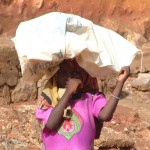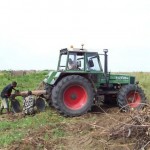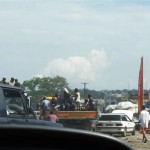Unless the gap between small-scale farming and the efficient marketing of agricultural products is bridged, poverty in the Great Lakes Region of Africa will grow
unabated. Poverty is one of the elements that triggered Rwanda’s genocide in 1994, socio-economic insecurity in Uganda, DRC and Burundi. In the case of Rwanda for example, rural poverty is sustained by residual fear of genocide revenge and by a large movement of peasants from rural to urban areas in search of jobs. If you look closely it seems likely genocide can feed poverty and vice versa in Rwanda.
While the urban ‘centre’ is being populated, the rural ‘periphery’ is being depopulated with the consequence that Rwanda’s rural communities are being deprived of a viable work force. The same realty is being observed in Burundi and Uganda. There’s urgency as the above mentioned situation combined with the current depressed state of the global economy chances are that an entire generation in the Great Lakes Region cannot expect to see light at the end of the economic tunnel any time soon. Therefore excessive reliance to humanitarian aid by the whole region has a risk to substitute itself to sustainable development and become a permanent feature.
The ownership society
Prior to the advent of colonialism, countries of the Great Lakes Region of Africa practiced a farmer-driven market economy. People owned land and farms and their economic destiny. No one was given fish or taught to fish; instead people knew how to fish and how to sell the fish and how to reinvest or save their earnings. Just like many countries around the world, farmers in these countries enjoyed a dynamic equivalent of accomplished businesses and millionaires. They were well acquainted with the advantages of linking rural production and the urban market. They knew that families can only meet their basic needs when they can produce their farm produce and sell their farm produce. When this link is severed, dependency on exogenous resources becomes necessary. Farmers were also aware that building and maintaining good communication infrastructure, reinforcing law, and maintaining order was a sine qua non for market-driven economic development. The whole community shared and owned this vision to the extent that the weekly market was perceived far and wide as part of the social fabric and part of the culture. The today ecotourism did exist. Everyone from the chief of the village to the average citizen participated in creating an environment conducive to progress by protecting land, by avoiding pesticides, by producing organic food, and by eating healthy food.
Paradigm Shift
Years later, the post-independence Rwanda, Uganda, DRC and Burundi adopted the collective approach championed by Marxist-Communist countries and thus destroyed this indigenous economic development system. The net result was a paradigm shift, governments of these four countries choose the China economic mantra: “Give-me- the -fish- I will -eat- and- I- will- again- be- angry- but- teach- me- to-fish- and- I- will- develop. Clearly, the missing ingredient in a system adapted from foreign ideology was the indigenous farmers’ market.
…Don’t Lead us to Relief Aid Temptation…
From bad to worst many years later in the ’80s, western relief aid poured into the Great Lakes region of Africa and reinforced the ‘give-me-the-fish-model’ by distributing foods and non-food items randomly without regard for indigenous economic systems. This “rescue-us-mission” approach was borrowed from the post World War II relief aid intervention in Europe. There too, as in post-independent Rwanda, NGOs became the killers of the farmer-driven market economy. They instead created dependency by offering a random band-aid to the
local economy. For decades genuine local farmers’ markets, if they didn’t disappear in some villages, remained overshadowed by the relief aid, which was said “an expression of God’s
presence for some and for others a western humanity’s response to Africa humanitarian crisis. Local corn producers for example had no reason to produce corn as corn flour from USA for example was distributed by the relief agencies. Dependency on foreign aid plunged the Great Lakes countries into becoming among the most heavily indebted countries in the world. While the International Monetary Fund and World Bank enslaved regional governments, Western private relief agencies, faith-based relief agencies, and governmental agencies such as the American’ USAID, the British’s DFID, the Canadian’s CIDA, and even the UN agencies, such the World Food Program (WFP) created dependency on hand outs. Pictures were
taken showing naked women and malnourished children lining at the food distribution centre. Reports sometimes with anecdotal evidence and not scientific data were written and disseminated around the world. That was then what about now?
What has to be done to reinvent a farmers’ market-driven economy:
1. Cost -Benefit Analysis: Revision of budget percentage allocation for funding economic development projects; Sometimes more money goes to buy expensive trucks or 4
wheel-drive vehicles, which often times are used only for staff transportation or for organization branding.
2. Adopt Simultaneous Approach: Relief agencies and donors, private or public, have to adopt the simultaneous approach by linking three activities together and implementing them
simultaneously: While doing Relief aid distribution for short term solution, seed and tool are being distributed and an assessment for a farmers’ market location(s) and day(s) is being conducted.
3. Negotiate with the local community the Creation of Consumers- Producer Cooperatives: through which agricultural products are sold directly to shareholder consumers.
Thus, earnings from the sale of farm produce goes directly to the producers. This is a win-win solution. Farmers will always have money and consumers will always have food to feed their families.
4. Forward Thinking: Enhance targeted capacity: organize training of farmers to teach them what to do with produce that cannot be sold such as tomatoes, bananas, pine apple etc…
5. Link Farmers to an Agriculture Bank or Create a Farmers’ market Cooperative: Now that we created an incentive among farmers thanks to consumer-producer cooperatives, we can start assessing the need of Agriculture banks or cooperatives to lend money to farmers because, as one can see, there’s a need for small scale industry to make plastic containers to be used for the conservation of transformed products.
6. Emphasize a Green Economy: Plastic containers can be made by recycling’ garbage collected items.
7. Job Creation: Because there’s no more waste, garbage collection will need collectors.





